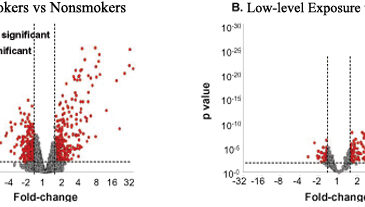Epidemiological research shows that individuals exposed to low levels of cigarette smoke (e.g., occasional smoking, environmental exposure, etc.) are at risk for developing lung problems (e.g., disease, decreased lung function, respiratory issues, etc) (Chan-Yeung & Dimich-Ward, 2003; Flouris et al., 2009). This week, ASHES reviews an article that explores whether biological data confirms the epidemiological data by examining genetic features of the lungs of people with different exposure levels to cigarette smoke (Strulovici-Barel et al., 2010 Online First).
Methods
- Researchers recruited study participants (n=121) from New York City using advertisements in local papers and electronic bulletin boards.
- Inclusion criteria: Participants had to be at least 18 years old, not pregnant, of normal health (as evidenced by physical exam), and have no history of lung-related issues, take no lung-related medication, and have had no alcohol/drug abuse during the past 6 months.
- Researchers categorized participants into three groups:
- Nonsmokers (n=40): Participants who reported no lifetime smoking with non-detectable nicotine and cotinine levels (i.e., <2 and <5 ng/ml, respectively).
- Active Smokers (n=45): Participants who reported smoking daily with ≥1000 ng/ml nicotine and/or >1000 ng/ml cotinine levels.
- Low-level Exposure (n=36): Participants who reported some lifetime smoking (n=28) or no lifetime smoking (n=8) and evidenced urine nicotine and cotinine levels higher than nonsmokers but lower than active smokers.
- The researchers performed a lung biopsy on the first area (i.e., small airway epithelium) where cigarettes typically affect lung cells (Harvey et al., 2007) to identify genetic material.
Results
- The researchers determined that 372 genes of 612 genetic probe sets (i.e., a specific DNA sequence) expressed differently for active smokers compared with nonsmokers. Further, of these 372 genes, 128 were different between low-level smokers and nonsmokers; however, only 41 differed between low-level smokers and active smokers.
- To illustrate, Figure 1 shows the pattern of genetic differences of active smokers compared to non-smokers – the genes were slightly more likely to regulate up for active smokers. A similar pattern was observed for the fewer genes that expressed differently for nonsmokers versus low-level smokers.

Figure. Lung biopsy comparison of genetic differences (from Strulovici-Barel et al., 2010 Online First). Click image to enlarge.
Please note: In A, the Active Smokers were compared to Nonsmokers (n=612 probe sets). In B, the Low-level Exposure was compared to Nonsmokers (n=128 probe sets). For each t-test comparing the genetic expressions of the probe sets, the figures plot the associate p-values by the probe set fold change (i.e., the average expression value of each probe set in all smokers divided by the average expression value in all nonsmokers). This illustrates graphically the extent of statistically significant differences for the group comparisons.
Limitations
- These researchers supplemented participants’ self-reported smoking behavior with urine samples; however, the nicotine and cotinine levels from the urine samples could not distinguish whether participants from the Low-level Exposure group were occasional smokers or nonsmokers exposed to environmental (i.e., second-hand) smoke.
- This study was cross-sectional; therefore, the researchers cannot conclude that the biological changes among the Low-level Exposure group will cause lung problems.
- This research examined small samples. Therefore, compared to large samples, the differences between small groups must be larger to reach statistical significance. Larger samples might yield statistical differences that implicate more gene differences.
Discussion
The results indicate that the biogenetic data is consistent with the epidemiological data, confirming that even low-level exposure to smoke is risky to physiological health. The results show that the risk for developing lung problems is certainly lower among people with low smoke exposure compared to those who actively smoke; non-smokers have even less risk than those who have low exposure to tobacco smoke. The population of people exposed to low levels of tobacco smoke worldwide is large. This places a large segment of the population at risk for respiratory disorders (Chan-Yeung & Dimich-Ward, 2003).
-Tasha Chandler
References
Chan-Yeung, M., & Dimich-Ward, H. (2003). Respiratory health effects of exposure to environmental tobacco smoke. Respirology, 8(2), 131-139.
Flouris, A. D., Metsios, G. S., Carrillo, A. E., Jamurtas, A. Z., Gourgoulianis, K., Kiropoulos, T., et al. (2009). Acute and short-term effects of secondhand smoke on lung function and cytokine production. American Journal of Respiratory and Critical Care Medicine, 179(11), 1029-1033.
Harvey, B. G., Heguy, A., Leopold, P. L., Carolan, B. J., Ferris, B., & Crystal, R. G. (2007). Modification of gene expression of the small airway epithelium in response to cigarette smoking. Journal of Molecular Medicine, 85(1), 39-53.
Strulovici-Barel, Y., Omberg, L., O’Mahony, M., Gordon, C., Hollmann, C., Tilley, A. E., et al. (2010 Online First). Threshold of biologic responses of the small airway epithelium to low levels of tobacco smoke. American Journal of Respiratory and Critical Care Medicine.
What do you think? Please use the comment link below to provide feedback on this article.




